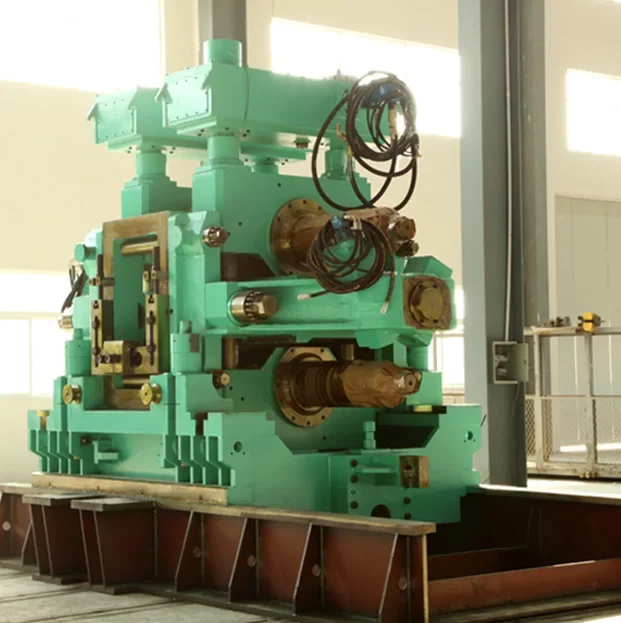Rolling is a continuous process, during which the input material is deformed between the rotating work rolls. Rolling mill is the place where rolling takes place. The roll gap (a gap between the work rolls) is smaller than the material entry height. As per the direction of passing the rolling stock between the work rolls, the position of rolls axes in relation to the rolling stock, and the course of rolling, a rolling mill can be categorized into longitudinal rolling mill, cross- rolling mill, and diagonal rolling mill.
In the longitudinal rolling, rolls are driven and they draw the material in-between and press it through the height. Due to it, the rolled material is considerably extended (elongated) and spread to a lesser extent. The longitudinal rolling is most popular method of rolling. Longitudinal rolling with plain rolls is used to roll flat rolled products (sheets, plates, strips), while longitudinal rolling in grooved rolls is used for shaped rolled products (rails, sheet piles, bars, sections, and wire rod).
The cross rolling mode is characterized by the fact that the axis of the rolled product is parallel with the rolls axes. The rolls are rotating in the same direction. The rolling stock is rotating in the direction of acting the resulting friction forces, i.e. in the opposite direction than is the direction of work rolls. This mode of rolling is used for the production of shafts or for rolling of grinding balls etc.
Diagonal rolling is a special case of cross rolling. The mechanism of plastic deformation is here a similar one. However, work rolls axes are not parallel, but skew. So, the rolling stock not only rotates, but also feeds forward in the direction of its longitudinal axis, because of the skew axes of the rolls. This mode of rolling is used for the rolling of seamless tubes. It is the popular method for the production of hollow semi-finished products.
Types of rolling mills with different numbers of rolls
Two-high rolling mills – These are the most commonly used rolling mills. These mills have two horizontally mounted rolls. The rolling mill motor drives either both rolls (top and bottom) or only one roll (normally the bottom roll with the top roll rotating due to the friction between the roll and the rolling stock). As per the rolls rotation direction the mill can be non-reversing (unidirectional) mill or reversing mill.
Three-high rolling mills – These types of rolling mills are with three horizontally mounted rolls. Rolls in these mills rotate permanently in one direction. These mills make it possible rolling with increased number of grooves than in case of two-high mill stands. The rolled stock is rolled in one direction between the bottom and intermediate roll and in the opposite direction between the intermediate and top roll. The fix-fitted intermediate roll is directly driven. The bottom and top roll are driven via the gearbox and they are usually adjustable. These mills are used for the rolling of the shaped rolled products in grooved rolls.
Four-high rolling mills – These mills have four horizontal rolls, mounted in a single vertical plane. Two rolls (inner) are work rolls and two rolls (outer) are back-up rolls. Significance of the back-up rolls consists in a chance of using higher roll forces and decrease in bending (deflection) of work rolls. Small diameters of work rolls also permit (except for greater elongation of the rolling stock) a possibility of achieving of more favourable dimensional thickness deviations. The work rolls of the four-high mill are driven while the back-up rolls are friction driven. The four-high mill is used for rolling of plates and for hot and cold rolling of steel strip. It is used both as non-reversing or reversing rolling mill.
Multi-roll mills – These rolling mills consist of six, seven, twelve or twenty horizontally mounted rolls. In all these mills there are only two rolls which are work rolls while all the other rolls are back-up rolls. Normally work rolls are driven and back-up rolls are friction driven. The multi-roll mills are used for rolling of very thin sheets, strips and foils.
Universal rolling mills – These mills have two horizontally mounted rolls and two vertically mounted rolls which are driven via transmission of bevel gear wheels. The vertical rolls act by edging effect on lateral sides of the rolling stock, which leads to creating its lateral ‘walls’, precision angles and sharp edges. The edging rolls used to be mounted from the front of the mill stand, less frequently from the rear side, but sometimes also from both sides of the mill. Universal rolling mills are used for rolling of slabs, universal plates and steel shapes. To enable rolling of wide-flange beams, the vertical rolls are mounted in the same plane with axes of rolls placed horizontally. Only the horizontal rolls are driven.

Universal rolling mill manufacturer
There is an excellent Universal rolling mills manufacturer, Yushun Metallurgical Co., Ltd, which sells high-quality Universal rolling mills. If you want to know more about it, or are interested in our products, you can visit the website to contact us.